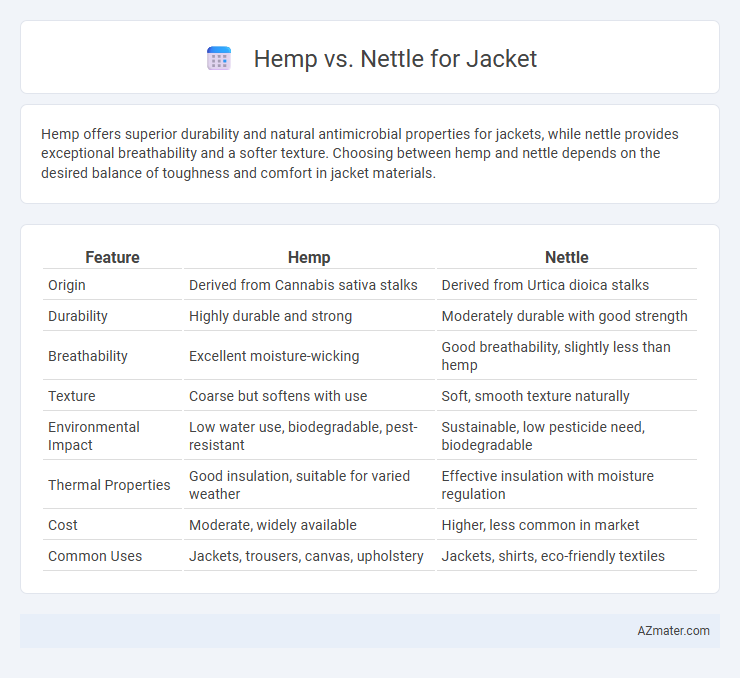Hemp offers superior durability and natural antimicrobial properties for jackets, while nettle provides exceptional breathability and a softer texture. Choosing between hemp and nettle depends on the desired balance of toughness and comfort in jacket materials.
Table of Comparison
| Feature | Hemp | Nettle |
|---|---|---|
| Origin | Derived from Cannabis sativa stalks | Derived from Urtica dioica stalks |
| Durability | Highly durable and strong | Moderately durable with good strength |
| Breathability | Excellent moisture-wicking | Good breathability, slightly less than hemp |
| Texture | Coarse but softens with use | Soft, smooth texture naturally |
| Environmental Impact | Low water use, biodegradable, pest-resistant | Sustainable, low pesticide need, biodegradable |
| Thermal Properties | Good insulation, suitable for varied weather | Effective insulation with moisture regulation |
| Cost | Moderate, widely available | Higher, less common in market |
| Common Uses | Jackets, trousers, canvas, upholstery | Jackets, shirts, eco-friendly textiles |
Introduction: Comparing Hemp and Nettle for Jackets
Hemp and nettle fibers offer sustainable alternatives for jacket materials, valued for their durability and eco-friendly properties. Hemp provides high tensile strength, moisture-wicking, and natural resistance to UV rays and mold, making it ideal for long-lasting outerwear. Nettle fibers boast a soft texture with excellent breathability and insulation, promoting comfort in varying climates while maintaining biodegradability.
Historical Use of Hemp and Nettle in Textiles
Hemp has been historically prized for its durability and strength, extensively used in ancient fabrics, ropes, and sails dating back thousands of years, especially in Asia and Europe. Nettle fibers, though less common, were traditionally valued in Europe for their soft texture and natural resistance to pests, serving as an eco-friendly alternative to flax and hemp in textile production. Both plants contributed significantly to sustainable fabric development, with hemp's coarse fibers ideal for heavy-duty jackets and nettle's fine fibers suited for lighter, breathable garments.
Fiber Characteristics: Hemp vs Nettle
Hemp fibers are known for their exceptional strength, durability, and resistance to stretching, making them ideal for long-lasting jackets that withstand wear and tear. Nettle fibers offer a softer, finer texture with good thermal insulation properties, providing comfortable warmth without bulk. Both fibers are naturally breathable and moisture-wicking, but hemp's coarse texture contrasts with nettle's smooth feel, influencing the jacket's overall comfort and performance.
Sustainability and Environmental Impact
Hemp offers superior sustainability compared to nettle due to its rapid growth rate, minimal water requirements, and natural resistance to pests, reducing the need for pesticides. Nettle cultivation demands less intensive farming practices than traditional crops but still involves more water and processing energy than hemp. Both fibers provide eco-friendly alternatives to synthetic materials, yet hemp's ability to improve soil health and sequester carbon positions it as the more environmentally impactful choice for jacket production.
Durability and Strength Assessment
Hemp fibers exhibit exceptional durability and tensile strength, making them ideal for long-lasting jackets resistant to wear and tear. Nettle fibers, while also strong and eco-friendly, tend to have slightly lower tensile strength compared to hemp but offer good durability with a softer texture. For heavy-duty applications requiring maximum strength and abrasion resistance, hemp remains the superior choice in sustainable jacket materials.
Comfort and Wearability Factors
Hemp fabric offers superior breathability and natural moisture-wicking properties, making jackets comfortable for all-day wear in varied climates. Nettle fiber, known for its durability and stiffness, provides excellent resistance to wear but may require blending with softer materials to enhance comfort and flexibility. Both fibers contribute to sustainable fashion, but hemp jackets typically deliver greater softness and ease of movement compared to nettle-based alternatives.
Breathability and Moisture Management
Hemp fabric offers superior breathability due to its natural porous structure, effectively allowing air circulation and reducing heat buildup in jackets. Nettle fibers also provide good moisture management by wicking sweat away from the skin, promoting quick evaporation and enhanced comfort during wear. Both materials deliver sustainable, breathable options, with hemp excelling in airflow and nettle optimizing moisture control.
Aesthetic Qualities and Textile Finishes
Hemp fabric offers a rustic, coarse texture with natural color variations, lending jackets an organic, earthy aesthetic that softens over time while maintaining durability. Nettle textiles provide a smoother, silkier finish with a subtle sheen, creating refined, polished jackets ideal for a more sophisticated look. Both fibers accept a variety of finishes, but nettle fabric often exhibits superior dye uptake and drapes more fluidly compared to the sturdier, more textured hemp.
Cost and Availability for Jacket Production
Hemp fibers are generally more cost-effective and widely available for jacket production due to their high yield per acre and established industrial supply chains, making them a preferred choice for sustainable fashion manufacturers. Nettle fibers, while durable and eco-friendly, tend to be less common and more expensive because of limited cultivation and processing infrastructure, which restricts large-scale availability. Manufacturers seeking affordable and consistent material sources often opt for hemp to balance cost efficiency and environmental impact in jacket production.
Conclusion: Choosing the Best Natural Fiber for Jackets
Hemp offers exceptional durability, breathability, and natural resistance to mildew, making it ideal for long-lasting, eco-friendly jackets. Nettle fabric provides a softer texture and excellent moisture-wicking properties, enhancing comfort in varied climates. Selecting between hemp and nettle fabrics depends on whether durability or softness and breathability are the priority for your jacket.

Infographic: Hemp vs Nettle for Jacket
 azmater.com
azmater.com